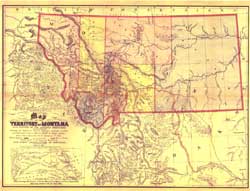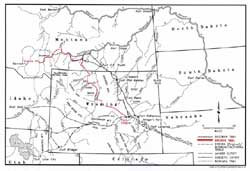|
In
1863 gold and silver were discovered at Alder Gulch in what is now
southwestern Montana. In 1864 prospectors, miners, and adventurers
flocked to the Montana Territory. A fast and safe route was needed
to get to the new gold fields. So, mountain man Jim Bridger blazed
a trail west of the  Bighorn
Mountains that was safer than the Bozeman Trail through Sioux country
in the Powder River Basin. Bridger's trail was much shorter than
the Oregon Trail and Lander Cutoff, or longer routes by way of Fort
Bridger or Salt Lake City. Bighorn
Mountains that was safer than the Bozeman Trail through Sioux country
in the Powder River Basin. Bridger's trail was much shorter than
the Oregon Trail and Lander Cutoff, or longer routes by way of Fort
Bridger or Salt Lake City.
Bridger's route was no accident.
Plains Indian societies were increasingly encroached upon due
to United States Manifest Destiny, followed by gold discoveries,
and settlement in the West. The primary reason Bridger blazed
his trail was to avoid the hostilities of the Lakota Sioux and
their allies, the Northern Cheyenne and Northern Arapaho. They
wanted for themselves the rich hunting grounds of the Powder River
Basin assigned to them in 1851 as an integral part of the Fort
Laramie Treaty. During the mid-1860s, the Sioux carried out "Red
Cloud's War", a campaign to force Euro-Americans and the
U.S. Army from the Powder River country. Their efforts resulted
in the closure of the Bozeman Trail and abandonment of the forts
as part of the Fort Laramie Treaty of 1868.
The Bridger Trail route to the gold
fields of Montana did not gain military support and lasted only
one season as an emigrant route. It was important nevertheless
because it funneled a large number of emigrants (approximately
25 percent of the 1864 population of Virginia City) into Montana
during a single trail season. Many of the emigrants homesteaded,
rose to prominence in  their
communities, and made important contributions to territorial development
and much more. Of course, the trail is also historically significant
for its association with Jim Bridger
who was notable for his contributions to the development of the
American West as one of the most renowned explorers and guides
in American history. their
communities, and made important contributions to territorial development
and much more. Of course, the trail is also historically significant
for its association with Jim Bridger
who was notable for his contributions to the development of the
American West as one of the most renowned explorers and guides
in American history.
Three decades later in the 1880s
and 1890s, the main Bridger Trail route served as the trunk line
for a freighting network of wagon roads that connected remote
ranches in the Lost Cabin area with Casper to the east and the
Bighorn Basin to the north. The route also provided rural communities
in the Bighorn Basin access to markets via the railhead in Billings,
Montana. This was important for sustaining the emerging economies
of those towns into the twentieth century. The Chicago, Burlington
and Quincy Railroad was built into the Bighorn Basin by 1901,
but freight wagons continued to transport a variety of merchandise
to and from the railheads along portions of the old Bridger Trail
prior to the advent of motorized transportation.
Bridger's trail served two historic
roles. It was a safer route for emigration to Montana during a
period of Native American resistance to Euro-American encroachment,
and it was the genesis of a late nineteenth and early twentieth
century transportation route that fostered early settlement in
a region without a system of roads.
|
 |